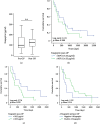Serum Levels of Kisspeptin Are Elevated in Patients with Pancreatic Cancer
- PMID: 31772690
- PMCID: PMC6854939
- DOI: 10.1155/2019/5603474
Serum Levels of Kisspeptin Are Elevated in Patients with Pancreatic Cancer
Abstract
Pancreatic adenocarcinoma (PDAC) still represents a devastating disease associated with a very limited survival. Novel biomarkers allowing an early diagnosis as well as an optimal selection of suitable treatment options for individual patients are urgently needed to improve the dismal outcome of PDAC patients. Recently, alterations of Kisspeptin serum levels, a member of the adipokine family, were described in various types of cancers. However, the role of circulating Kisspeptin as a biomarker in PDAC patients is poorly defined. In this study, we measured Kisspeptin serum levels in a cohort of 128 prospectively enrolled PDAC patients undergoing surgical resection as well as 36 healthy controls. Kisspeptin concentrations were elevated in PDAC patients compared to control samples. Nevertheless, Kisspeptin serum levels were independent of tumor-related factors such as the tumor grading, TNM stage, or clinical features such as the ECOG performance status. Finally, in our analysis, neither preoperative nor postoperative Kisspeptin levels turned out as a significant predictor of overall survival after tumor resection. In conclusion, our data suggest that Kisspeptin concentrations are altered in PDAC patients but do not allow to predict patients' outcome after resection of PDAC.
Copyright © 2019 Sven H. Loosen et al.
Conflict of interest statement
The authors declare that they do not have any competing interests related to this manuscript.
Figures



References
MeSH terms
Substances
LinkOut - more resources
Full Text Sources
Medical

